|
Well, we have now lived in our house for seven months and have six months of detailed data. As of April 1st we have just over 1000kWh surplus. Our modeled energy use for these first six months is about 11,600 kWh. Our actual power use has been just over 7,700 kWh! Now that the heating season is basically over, we expect that surplus to grow even more over the spring and summer. With our first winter "in the books", we have learned a lot about how we use energy. Here are a few of the highlights...
When I created this blog, I had calculated that we would drive about 24,000 miles annually between both of our vehicles. This was 8,000 miles less than before we moved. In the last six months, we have driven a total of 7487 miles. We expect to drive more in the summer, but not all that much more. Taking that into account, if we drive another 10,000 miles in the next six months, that puts us at about 17,500 miles annually. What I didn't take into account was just how much we enjoy our house! I find myself leaving the house less often. I used to run errands or trips just because I was bored. Our new house is a much more comfortable, inviting place to be. And so, I have found I drive less. In addition to Kate's work being much closer, our errands to places such as Target, Best Buy, bookstores, etc are also much closer. In general, a third to half the distance they used to be. Recently I started looking at how much power we use at different times of the day.
Just above you can see a graph showing how much power we used each hour. This combines all days between October 1st and April 1st.. The blue line is our total power use except for the cars. Up until March, I was charging a car many times during peak sunshine hours to allow our solar array to work at 100%. Because of this, we had an artificial peak around 11am-2pm that doesn't represent what will be our typical use. As such, I have excluded the power for the cars from this graph. The orange line is the HVAC power. The green line is for our major appliances. The heating tends to reach a peak in the early morning, than falls off during the day when we get free passive solar heating. The stored heat lasts into the night, but needs some help from the mechanical system. More and more power is used by the mechanical heating system until the peak around 6am. Dinner time gives us a peak for appliances which makes sense. It is our main meal and the one we most often have the cooktop, oven, microwave running. We also tend to run the dishwasher after dinner. Another thing to keep in mind is that we had a relatively warm winter. In a more typical winter more energy would have been needed. Final approvals for the rest of our LEED and Greenstar certifications are due soon. Lots of paperwork involved, but we can see the light at the end of the tunnel! Happy Earth Day everyone! |
AuthorMark really doesn't like to talk about himself, the house is much more interesting. Archives
September 2020
Categories
All
|

